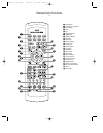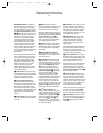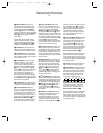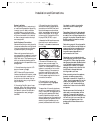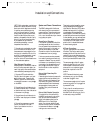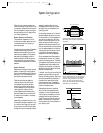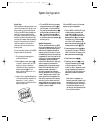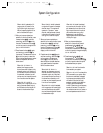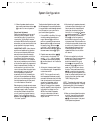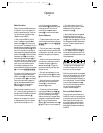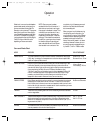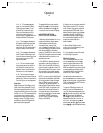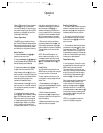System Configuration
19
11. When all speaker selections have
been made, press the Set button i
˜ to return to normal operation.
Output Level Adjustment
Output level adjustment is a key part of
the configuration process for any sur-
round sound product. It is particularly
important for a Dolby Digital receiver
such as the AVR45, as correct outputs will
ensure that you hear sound tracks in their
proper place with the proper intensity.
IMPORTANT NOTE: Many listeners
are often confused aboutthe operation
of the surroundchannels. While some
assume that soundshould always be
coming from eachspeaker, most ofthe
time there willbe little or nosound in
the surround channels.This is because
they are onlyused when a moviedirector
or sound mixerspecifically places sound
there to create ambiance,an effect or to
continue action from the front of the
room to the rear. Whenthe output levels
are properly set itis normal for rear/
surround speakers to operate only
occasionally. Artificiallyincreasing the
volume to therear speakers may destroy
the illusion ofan enveloping sound field
that duplicates theway you hear sound
in a movietheater or concert hall.
Before beginning the adjustment process
make certain that all speaker connections
have been properly made. The system
volume should be set to the level that
you will use during a typical listening
session. Finally, make certain that the
Balance Control 7 is set to the center
“12 o’clock” position.
To adjust and calibrate the output levels,
follow these steps. For accurate calibration,
it is a good idea to make these adjustments
from the location in your room that is
your favorite listening position:
1. Put the AVR45 in the Dolby Pro Logic
mode by pressing the Dolby Pro
Logic Selector Ó on the front
panel or by pressing the Surround
Mode Selector yon the remote,
followed by the
⁄
/
¤
buttons g
until PRO LOGIC appears in the
Main Information Display S and
the PRO LOGIC indicator F lights.
2. Press the Test Tone button eÒ
on the remote or front panel. The
words T-TFL 0dBwill appear
in the Main Information Display
S, and the letters FL will flash once
each second.
3. At this point, the test noise will begin
to circulate among all the speakers in
a clockwise rotation.
NOTE: This is a good time to verify
that the speakers have been properly
connected. As the test noise circulates,
listen to make certain that the sound
comes from the speaker position
shown in the Main Information
Display. If the sound from a speaker
location does NOT match the position
indicated in the display, turn the
AVR45 off and check the speaker
wiring to make certain that each
speaker is connected to the correct
output terminal.
4. After checking for speaker placement,
let the test noise circulate again, and
listen to see which channels sound
louder than the others. Using the
front left (FL in the display) speaker
as a reference, press the
⁄
/
¤
buttons
g on the remote or the Selector
buttons¸ on the front panel on
each channel to begin to bring them
to the same level. Note that when one
of the buttons is pushed, the test noise
circulation will pause on the channel
being adjusted to give you time to
make the adjustment. When you
release the button, the circulation
will resume.
5. Continue to adjust the individual
speakers until they all have the same
volume. Note that adjustments
should be made with the
⁄
/
¤
buttons g on the remote or the
Selector buttons¸ on the front
panel only, NOT the main volume
controls. Then press the Set button
i˜to memorize the change. If
you are using a sound pressure (SPL)
meter for precise level adjustment, set
the volume so that the meter reads
75dB, C-Weighting Slow.
NOTE: The subwoofer output level is not
adjustable using the test tone. To change
the subwoofer level, follow the steps for
Output Level Trim Adjustment on page
27.
6. When you have adjusted the outputs
so that all channels have the same
level, press the Test Tone button
eÒon the remote or front panel
to complete the adjustment.
AVR45 om (G).Eng,Fr 4/16/99 11:41 AM Page 19



